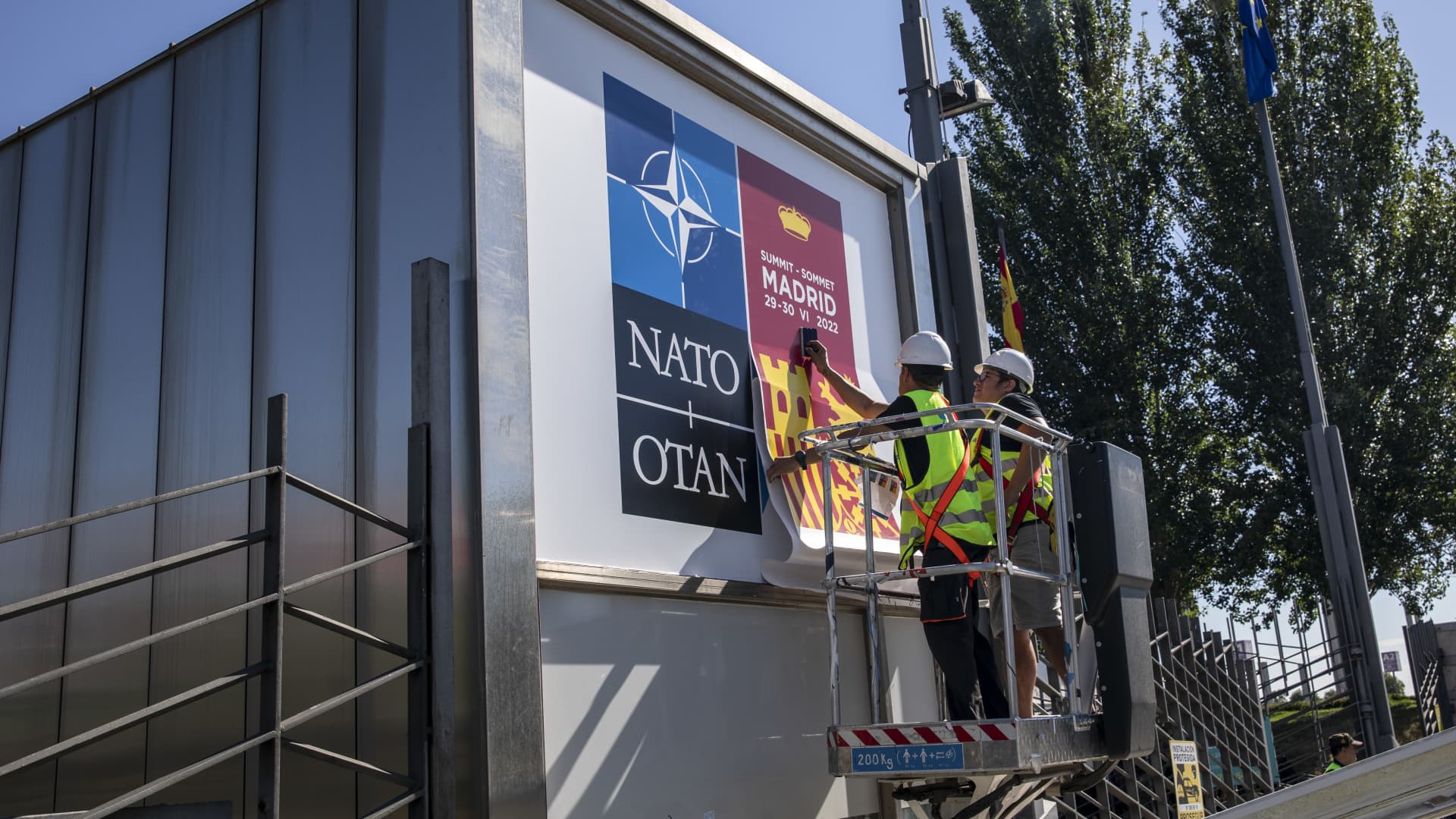
- NATO chief Jens Stoltenberg said Tuesday that the 30-member military alliance would reduce emissions by at least 45% by 2030 and reach net-zero emissions by 2050.
- Fossil fuel-guzzling armies, navies and air forces are major contributors to carbon emissions.
- Military activities have quietly enjoyed a sense of exceptionalism from environmental norms that other areas of society are expected to follow.
The super-polluting military alliance of NATO announced Tuesday its first emissions reduction targets, pledging to recognize the deepening climate emergency as "a defining challenge of our time."
Speaking in Madrid, NATO chief Jens Stoltenberg said the 30-member alliance would reduce emissions by at least 45% by 2030 and reach net-zero emissions by 2050.
"It will not be easy. But it can be done," Stoltenberg said.
Get top local stories in Southern California delivered to you every morning. Sign up for NBC LA's News Headlines newsletter.
"We cannot compromise our military effectiveness. NATO is about preserving peace through a credible deterrence and defense. Nothing is more important," he added.
"If we fail to preserve peace, we also fail to fight climate change. At the same time, we also have a responsibility to reduce emissions."
Fossil fuel-guzzling armies, navies and air forces are major contributors to carbon emissions. Indeed, the world's largest armed forces have been shown to emit more greenhouse gas emissions than many countries combined.
Money Report
Research by Scientists for Global Responsibility estimates that the world's militaries, and the industries that provide their equipment, account for as much as 6% of all global emissions.
Despite this, military activities have quietly enjoyed a sense of exceptionalism from environmental norms that other areas of society are expected to follow.
For instance, military activities are typically excluded from emissions inventories and emissions targets, and the voluntary nature of reporting to the U.N. Framework Convention on Climate Change means governments' emissions data is often either absent or incomplete.
"It's an empty pledge. I would actually call it — albeit encouraging that they are speaking about it — somewhat disingenuous," Ben Neimark, senior lecturer at Lancaster University, told CNBC via telephone. Neimark is part of a group of social scientists calling for improved government transparency over the scale of carbon emissions from their armed forces.
"As if some of the largest polluters in the history of mankind by institution is going to somehow tell us that they are going to go net-zero without providing us the data plane which they are basing this pledge, and/or the meaningful cuts that are based on non-existing data. Right? It's fairly disingenuous," Neimark said.
New security agenda
NATO leaders are gathering in the Spanish capital this week to outline their vision for the West's security agenda.
The so-called Strategic Concept, which is updated roughly every decade, is recognized as NATO's most important document. It will reaffirm the values of the 30-member alliance, provide a collective assessment of security challenges and act as a guide to the group's political and military development.

Stoltenberg said the updated Strategic Concept will likely refer to Russia as the "most significant and direct threat" to security in the wake of President Vladimir Putin's onslaught in Ukraine, while the challenges posed by China are also set to be addressed for the first time.
It will also state that climate change is "a defining challenge of our time," Stoltenberg said. "For NATO, this means three things. Increasing our understanding, adapting our Alliance and reducing our own emissions," he said.
On Monday, NATO announced plans to increase the number of its high-readiness forces to well over 300,000 as part of the alliance's "biggest overhaul of collective defense and deterrence since the Cold War."
It is expected that such a massive military buildup in response to Russia's war in Ukraine will require further investment from NATO members.
"Now Russia has invaded Ukraine, all existing plans have been thrown out the window," Stuart Parkinson, executive director at Scientists for Global Responsibility, told CNBC via telephone.
"So, you've seen increases in military spending being announced and that will be accompanied by increases in military carbon emissions — which were already increasing anyway," Parkinson said. "In basic terms, they were already heading in the wrong direction, and they are still going to be heading in the wrong direction — just even more so."
NATO agreed in June last year to "significantly reduce" greenhouse gas emissions from military activities and "assess the feasibility" of reaching net-zero emissions by 2050.
Stoltenberg said all allies were committed to reducing their greenhouse gas emissions as part of the landmark 2015 Paris climate accord.
According to the United Nations, net-zero means slashing greenhouse gas emissions to as close to zero as possible, with any remaining emissions re-absorbed from the atmosphere.
Governments and corporations are under immense pressure to reduce their environmental impact to stave off the worst of what the climate crisis has in store.
'Only what gets measured can get cut'
NATO's Stoltenberg, a former U.N. special envoy on climate change, said the alliance has developed its first methodology for measuring NATO's greenhouse gas emissions, civilian and military.
"It sets out what to count and how to count it. And it will be made available to all Allies to help them reduce their own military emissions," Stoltenberg said. "This is vital because only what gets measured can get cut."
He had previously conceded at last year's COP26 climate summit in Glasgow, Scotland, that net-zero would not be possible without including military emissions.
Campaigners had argued ahead of the Madrid summit that for NATO's climate plans to be credible, the alliance needed to produce a comprehensive and publicly available methodology of their emissions data.
That's because little reliable data on military emissions exists at a time when the world's leading climate scientists are sounding the alarm over the fight to keep global heating under the critically important threshold of 1.5 degrees Celsius.

"For me, the methodology is probably the key thing," Jamie Shea, secretary-general of the Global Military Advisory Council on Climate Change, told CNBC via telephone.
"The NGO community will want this to be a public methodology so that it is not just left for NATO to decide if it is doing well or not, but the community of climate science can also say whether this is a proper methodology and if NATO is really moving in that direction," Shea said.
Doug Weir, research and policy director at the Conflict and Environment Observatory, a non-profit based in the U.K., said transparency over the full scope of NATO's military emissions would be necessary if the alliance is to meaningfully identify cuts.
"Currently, we are nowhere near a stage where we can say 'this is how much the military sector contributes to climate change every year.' Nowhere near that, and it is really important to be able to do that," Weir told CNBC.
"We need militaries to show real urgent leadership on this because this stuff is going to take a long time. We are completely realistic about that — but the sooner you start the sooner you get there."
Energy transition
Stoltenberg said the climate crisis has deeply affected the environment in which its troops operate, citing extreme heat for its training mission in Iraq, rising sea levels that threaten naval bases and hurricanes that have disabled airfields.
"The list is long," he said.
To that end, it's important for NATO to adapt to ensure its allied members "remain effective in increasingly harsh environments," Stoltenberg said.
NATO's secretary-general said a big part of how it plans to reach net-zero by the middle of the century stemmed from a transition away from fossil fuels.
That would include a pivot to renewable energy sources, "climate-friendly synthetic fuels and more energy-efficient solutions."
"The war in Ukraine shows the danger of being too dependent on commodities from authoritarian regimes. The way Russia is using energy as a weapon of coercion highlights the need to quickly wean ourselves off Russian oil and gas," Stoltenberg said.
"At the same time, we must not swap one dependency for another. Lots of new, green technologies and the rare earth minerals they require come from China. So we must diversify our energy sources and our suppliers," he added.
What needs to happen next?
When asked what militaries can do to reduce the emissions created by their military activities, SGR's Parkinson identified a number of "easy wins."
These include energy efficiency improvements at military bases, the installation of solar and wind energy generation and switching some vehicles to renewable energy sources.
"That should be part and parcel of what they are doing in the near term. And then you've got the difficult stuff: the operational and the equipment. There are technologies that could help but the bigger picture is that we need less confrontation between governments and militaries," Parkinson said.
He cited the urgent need for arms control agreements, particularly regarding some of the most destructive weapons, such as nuclear weapons and autonomous weapons.

"We've got to find some common ground and that means a messy, unpleasant compromise that no one is going to like to bring some sort of peace soon so that we can tackle the bigger problems," Parkinson said.
A critical test of the Madrid summit's integrity, said Shea of the Global Military Advisory Council on Climate Change, is whether NATO would be able to demonstrate a global perspective in dealing with security threats in addition to Russia's war in Ukraine.
Shea said former U.S. President Lyndon B. Johnson once quipped "that you have to be able to walk and chew gum at the same time."
"Obviously, although Russia-Ukraine is the big story … [there are] other problems like terrorism in Africa, climate change, the militarization of space [and] cyber conflict. All of these things are not put on hold or just magically disappear simply because of Russia and Ukraine," Shea said.
"I think the test in Madrid is that NATO shows that it is dealing with the Ukraine situation but also shows the commitment to take a broader view," he added.






